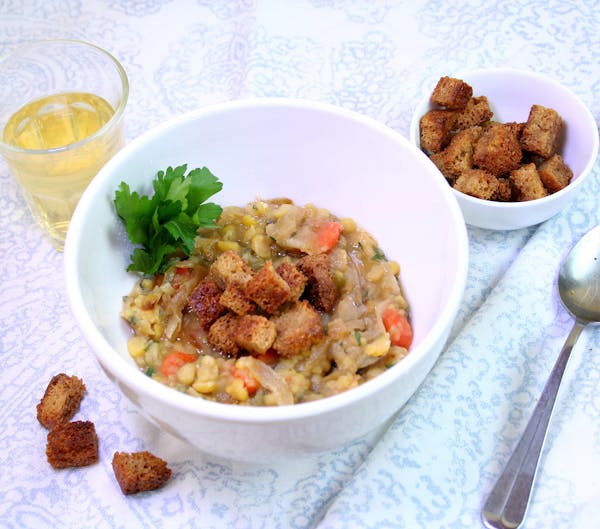Sometimes the tiniest things can make a big difference.
Take the lentil. One little lentil, smaller than a pencil eraser, seems inconsequential. But plant that lentil, and you can feed the world.
That's the idea behind the latest effort by the U.N. Food and Agriculture Organization which has designated 2016 as the International Year of Pulses.
"Pulse" refers to all dried beans, lentils, peas and chickpeas.
Yes, dried beans are getting a whole year of stardom. From the creaminess of the white bean to the nutty heft of the chickpea, to the comforting sweetness of a split pea, the crowd-pleasing tastes and textures of pulses are taking center stage.
Pulses, in all their humble glory, may well be the answer to the growing need for protein, as our global population continues to expand. Growing them is very sustainable, in part because legume plants have the added bonus of putting nitrogen into the soil. They actually fertilize the field as they provide a crop.
In many Third World countries, where small independent farmers grow pulses, the farming can keep them from poverty.
Here in the U.S., where heart disease is still the leading cause of death, pulses offer cholesterol-lowering, high-fiber goodness in an inexpensive package. According to the U.S. Department of Agriculture, a serving of lentils costs 10 cents, compared with beef at $1.49, pork at 73 cents and chicken at 63 cents. Pulses are also good sources of iron, potassium, folate and antioxidants.
If you aren't in the habit of cooking with dried beans and peas, try preparing a batch once a week.
Larger beans will need to be soaked; smaller lentils and peas can be cooked without soaking them. Once cooked, they can be used to make hummus, refried beans, soups, stews or other dishes.
Join in on the Year of Pulses and reap the benefits of plant-based proteins — and save money — all while enjoying good meals.
Yellow Split Pea Soup With Dijon Croutons
Serves 4.
Note: This soup gives a nod to the cuisine of modern-day Turkey, where evidence of lentil and pea cultivation goes as far back as 8000 B.C. By slowly sautéing onions while the split peas cook, you can amplify the earthy sweetness of an inexpensive vegetable, and boost the flavor of this simple soup. Crisp croutons with a kiss of Dijon mustard provide a textural contrast, and are a great way to economize by using up stale bread. From Robin Asbell.
• 1 c. yellow split peas, sorted and rinsed
• 1 large carrot, peeled and chopped
• 2 celery ribs, chopped
• 1 large bay leaf
• 4 c. water, approximately
• 1/2 c. dry white wine
• 1 tbsp. fresh oregano, coarsely chopped
• 1/4 c. fresh parsley, chopped
• 4 tbsp. extra-virgin olive oil, divided
• 2 large onions, slivered
• 1/2 tsp. salt, divided
• 1 tbsp. Dijon mustard
• 4 slices whole wheat bread, cubed (4 c.)
• 1/2 tsp. freshly ground black pepper
Directions
Preheat the oven to 300 degrees.
In a large pot, combine the yellow split peas, carrot, celery, bay leaf and 4 cups water. Stir and place over medium-high heat to bring to a boil. Reduce the heat to medium-low to achieve a gentle simmer, and cover the pot. Check every 10 minutes and adjust heat so it doesn't boil over. Cook for 40 to 50 minutes.
When the split peas are tender and falling apart, stir in the white wine, oregano and parsley, and simmer for 5 minutes longer to blend the flavors.
Meanwhile, caramelize the onions. In a large sauté pan, heat 2 tablespoons olive oil over medium-high heat. Add the onions and stir until they start to sizzle and soften, about 3 minutes. Reduce the heat to medium-low and stir every 5 minutes. The onions will shrink and turn caramel brown. Add 1/4 teaspoon salt to the onions.
In a large bowl, mix the Dijon mustard and remaining 2 tablespoons olive oil. Add the cubed bread and sprinkle with the remaining 1/4 teaspoon salt and add the pepper. Spread the cubes on a sheet pan and bake for 15 minutes, then stir, and bake for 15 minutes more. Stir again and bake for 15 minutes, until the croutons are crisp.
Serve individual cups of soup with onions swirled in and a topping of croutons.
Nutrition information per serving:
Calories390Fat15 gSodium560 mg
Carbohydrates49 gSaturated fat2 gTotal sugars7 g
Protein15 gCholesterol0 mgDietary fiber17 g
Exchanges per serving: 1 vegetable, 3 starch, ½ lean protein, 3 fat.
Robin Asbell is a cooking instructor and author of "Big Vegan," "The Whole Grain Promise" and "Great Bowls of Food." Find her at robinasbell.com.
Nancy Pelosi memoir, 'The Art of Power,' will reflect on her career in public life
UK's Prince William returns to public duties for first time since Kate's cancer diagnosis
Review: Sabrina Carpenter's 'cheeky, summery' 'Espresso' could be her biggest hit yet

8 Midwestern supper clubs that get it right

